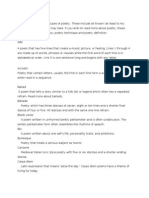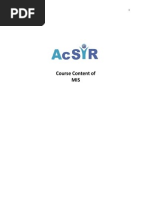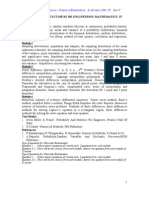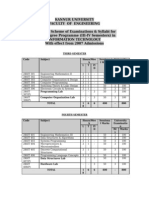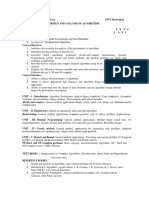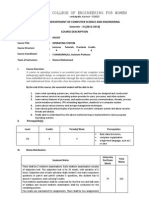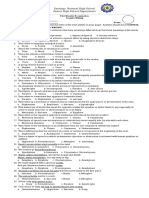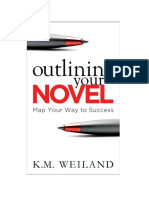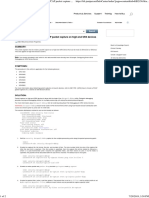Syllabus of M. Tech. Computer Science and Engineering
Uploaded by
Haidarali AnsariSyllabus of M. Tech. Computer Science and Engineering
Uploaded by
Haidarali AnsariSyllabus of M. Tech.
Computer Science and Engineering
Page 1 of 35
K. E. Societys Rajarambapu Institute of Technology, Rajaramnagar Department of Computer Science and Engineering Curriculum Structure M. Tech. Computer Science and Engineering
Semester - I
Teaching scheme Subject code Subject Evaluation Scheme Theory Practical (Marks %) (Marks%) Scheme ISE MSE ESE ISE MSE ESE ISE MSE ESE ISE MSE ESE ISE MSE CS 511 Multicore Architecture & Programming Enterprise Information Systems 3 1 -4 ESE 50
Max Min for passing Max Min for passing
Credits
CS501
Mathematical Foundations of Computer Science Design & Analysis of Algorithms Research Methodology
--
20 30 50 20 30 50 20 30 50 20 30 50 20 30
40
CS 503
--
40
CS 505
--
40
CS507
Advance Networks
Elective-I Soft Computing
--
40
CS 509
40
CS 513
ISE CS551 Seminar-I -2 -2 ESE CS553
60 40 40 60 40 40
Advanced Computing Lab-I
-15
-7
4 4
2 24
ISE ESE
Total Contact Hours / week = 26 Total Credits = 24 ISE In Semester Evaluation, MSE Mid Semester Exam., ESE End Semester Exam.
Page 2 of 35
K. E. Societys Rajarambapu Institute of Technology, Rajaramnagar Department of Computer Science and Engineering Curriculum Structure M. Tech. Computer Science and Engineering
Semester - II
Teaching scheme Subject code Subject Evaluation Scheme Theory (Marks Practical %) (Marks %) Scheme ISE MSE ESE ISE MSE ESE ISE MSE ESE ISE MSE ESE ISE MSE ESE ISE ESE ISE ESE
Max Min for passing Max Min for passing
Credits
CS502
Design of Databases Systems Parallel Algorithms & Design Natural Language Processing Advance Distributed system
Elective-II Wireless Sensor Networks Computer Vision & Virtual Reality Bio-informatics Seminar II Advanced Computing Lab-II
--
CS504
--
CS506
--
--
CS508
CS 510 CS 512 CS 514 CS552 CS554
20 30 50 20 30 50 20 30 50 20 30 50 20 30 50 -
40
40
40
40
40
17
2 06
2 2
2 1 24
60 40 60 40
40 40
Total Contact Hours / week = 25 Total Credits = 24 ISE In Semester Evaluation, MSE Mid Semester Exam., ESE End Semester Exam.
Page 3 of 35
M. Tech (COMPUTER SCIENCE & ENGINEERING) CS501 Mathematical Foundations of Computer Science
L 3
T 1
P -
Credits 4
SemI
1. Introduction : Mathematical notions and terminology of sets, sequences and tuples, functions and relations, graphs, strings and languages, Boolean logic properties and representation, Definition, Theorems and Types of Proofs Formal proofs, deductive, reduction to definition, proof by construction, contradiction, induction, counter-examples. (5) 2. Regular Languages : Finite automata, DFA, NFA, Equivalence of DFA & NFA. An application, Regular expressions and languages, applications. (5) 3. Context free languages : CFGs, Applications, Ambiguity removal, pushdown automata and Equivalence with CFGs. (4) 4. Turing Machine : Turing machines, variants of TMs, programming techniques for TMs, Restricted TMs, TMs and Computers. (4) 5. Decidability : Decidable languages, decidable problems concerning Context free languages, The halting problem Diagonalization method, halting problem is undecidable. (4) 6. Reducibility : Undecidable problems from language theory Regular expressions, Turing machines, Reduction. A simple undecidable problem (PCP), mapping reducibility, and other undecidable problems. (5) 7. Computability : Primitive recursive functions, computable functions, examples, the recursion theorem. (4) 8. Computational Complexity : Tractable and Intractable problems Growth rates of function, time complexity of TM, tractable decision problems, theory of Optimization. (5)
Page 4 of 35
Text books: 1. Introduction to Theory of Computation Michael Sipser (Thomson Nrools/Cole) 2. Introduction to Automata Theory, Languages and Computations J.E. Hopcroft, Rajeev Motwani & J.D. Ullman (Pearson Education Asia), 2nd Edition.
Reference books: 1. Introduction to languages and theory of computation John C. Martin (MGH) 2. Discrete Mathematical structures with application to Computer Science J.P. Tremblay and R. Manohar 3. Theory of Computer Science E. V. Krishnamoorthy
Term Work : It should consist of 10-12 assignments based on the syllabus. The students should be assigned at least 1 or 2 assignments of analyzing relevant articles from International journals and are further supposed to submit a report containing the analysis, alternatives in the design or solution, suggestions regarding improvements on the topics chosen. The term work is to be internally assessed.
Page 5 of 35
M. Tech (COMPUTER SCIENCE & ENGINEERING) CS503 Design And Analysis of Algorithms
L 3
T 1
P -
Credits 4
SemI
1. Divide and Conquer : The general method, Binary search, Mergesort, Quicksort, Selection sort and analysis of these algorithms (4) 2. Dynamic Programming : The general method, Multistage graphs, All pair shortest paths, Optimal binary search trees, 0/1 knapsack, Reliability design, Traveling Sales person problem. (5) 3. Basic Traversal and Search Techniques : Game Tree; Traversal Techniques for Graphs Breadth First Search & Traversal, Depth First Search & Traversal, AND/OR graphs; Connected components and Spanning Trees; Bi-connected components and Depth First Search.(4) 4. Lower Bound Theory : Comparison trees, Oracles and adversary arguments, Lower bounds through reductions. (6) 5. NP Hard and NP Complete Problems : Basic Concepts, Cooks Theorem, NP Hard Graph Problems, NP Hard Scheduling Problems, NP-Hard Code Generation Problems. (5) 6. Approximation Algorithms : Introduction, Absolute approximations, - approximations, Polynomial time approximation Schemes, Fully Polynomial Time Approximation Schemes, Probabilistically Good Algorithms. (5) 7. PRAM Algorithms : Introduction, Computational Model, Fundamental Techniques and Algorithms, Merging, Lower Bounds. (3) 8. MESH Algorithms : Computational Model, Packet routing, Fundamental algorithms, Merging, Computing the Convex Hull. (3) 9. HYPERCUBE Algorithms : Computational Model, PPR Routing, Fundamental Algorithms, Selection, Merging, Sorting, Computing the Convex Hull. (3)
Page 6 of 35
Text Books: 1. Fundamentals of Computer Algorithms - Ellis Horowitz, Satraj Sahani, Saguthevar Rajasejaran (Universities Press) Second Edition 2. Fundamentals of Computer Algorithms Ellis Horowitz, Sartaj Sahni and Sanguthewar Rajaselaran (Galgotia publications). 3. The Design and Analysis of Computer Algorithms Aho, Hopcraft & Ulman (Pearson Education) Reference Books: 1. Introduction to Algorithms Thomas H. Cormen, Charles S. Leiserson, Ronald L. Rivest and Clifford Stein (PHI) 2nd edition. 2. Randomized Algorithms Rajeev Motwani and Prabhakar Raghavan (Cambridge University Press). 3. Algorithm Design Foundations, Analysis and Internet Examples by Michael T. Goodrich, Roberto Tamassia (Wiley Student Edition)
Term Work : It should consist of 10-12 assignments based on the syllabus. The students should be assigned at least 1 or 2 assignments of analyzing relevant articles from International journals and are further supposed to submit a report containing the analysis, alternatives in the design or solution, suggestions regarding improvements on the topics chosen. The term work is to be internally assessed.
Page 7 of 35
M. Tech (COMPUTER SCIENCE & ENGINEERING) CS505 Research Methodology
L 3
T 1
P -
Credits 4
SemI
UNIT I
Research methodology: An Introduction Objectives of Research, Types of Research, Research Methods and Methodology, Defining a Research Problem, Techniques involved in Defining a Problem. UNIT II 6
Research Design Need for Research Design, Features of Good Design, Different Research Designs, Basic Principles of Experimental Designs, Sampling Design, Steps in Sampling Design, Types of Sampling Design, Sampling Fundamentals, Estimation, Sample size Determination, Random sampling. UNIT III 6
Measurement and Scaling Techniques Measurement in Research, Measurement Scales, Sources in Error, Techniques of Developing Measurement Tools, Scaling, Meaning of Scale, Scale Construction Techniques. UNIT IV 6
Methods of Data Collection and Analysis Collection of Primary and Secondary Data, Selection of appropriate method Data Processing Operations, Elements of Analysis, Statistics in Research, Measures of Dispersion, Measures of Skewness, Regression Analysis, Correlation. UNIT V 6
Techniques of Hypotheses, Parametric or Standard Tests Basic concepts, Tests for Hypotheses I and II, Important parameters limitations of the tests of Hypotheses, Chi-square Test, Comparing Variance, As a non-parametric Test, Conversion of Chi to Phi, Caution inusing Chi-square test.
Page 8 of 35
UNIT VI
Analysis of Variance and Co-variance ANOVA, One way ANOVA, Two Way ANOVA, ANOCOVA Assumptions in ANOCOVA, Multivariate Analysis Technique Classification of Multivariate Analysis, factor Analysis, R-type Q Type factor Analysis, Path Analysis
REFERENCE BOOKS: 1. Research Methodology, C.R. Kothari, Wiley Eastern. 2. Formulation of Hypothesis, Willkinson K.P, L Bhandarkar, Hymalaya Publication, Bombay. 3. Research in Education, John W Best and V. Kahn, PHI Publication. 4. Research Methodology- A step by step guide for beginners, Ranjit Kumar, Pearson Education 5. Management Research Methodology-Integration of principles, methods and Techniques, K.N. Krishna swami and others, Pearson Education
Page 9 of 35
M. Tech (COMPUTER SCIENCE & ENGINEERING) CS507 Advance Networks
L 3
T 1
P -
Credits 4
Sem-I Unit I Introduction Requirements , Network architecture , Networking principles, Network servicesand Layered architecture , Network services and Layered architecture , Future networks ( Internet , ATM , Cable TV, Wireless Bluetooth, Wi-Fi, WiMax,Cell phone ) 8
Unit II Advanced Technologies Virtual circuits, Fixed size packets, Small size packets, Integrated service, History, Challenges, ATM Network protocols, IP over ATM, Wireless networks : Wireless communication basics, architecture, mobility management, wireless network protocols. Ad-hoc networks Basic concepts, routing; Bluetooth (802.15.1), Wi-Fi (802.11), WiMAX (802.16), Optical Network : links, WDM system, Optical LANs, Optical paths and networks. 8
Unit III Performance of Networks Control of networks: objectives and methods of control, Circuit switched networks, atagram and ATM networks. Mathematical background for control of networks like Circuit switched networks, Datagram and ATM networks Unit IV Advanced Routing - I Routing architecture , Routing between peers ( BGP) , IP switching and Multi-Protocol Label Switching (MPLS), MPLS Architecture and related protocols, Traffic Engineering (TE) and TE with MPLS , NAT and Virtual Private Networks (L2, L3, and Hybrid), CIDR Introduction , CIDR addressing, CIDR address blocks and Bit masks Unit V Advanced Routing - II Mobile IP- characteristics, Mobile IP operation, Security related issues. Mobility in networks. Voice and Video over IP (RTP, RSVP, QoS) IPv6: Why IPv6, basic protocol, extensions and options, support for QoS, security, etc., neighbor discovery, auto-configuration, routing. Changes to other protocols. Application Programming Interface for IPv6. 8 8 8
Page 10 of 35
Unit VI Ad Hoc Networking An Introduction, A DoD Perspective on Mobile Ad Hoc Networks, DSDV: Routing over a ultihop Wireless Network of Mobile Computers, Cluster-Based Networks, DSR: The Dynamic Source Routing Protocol for Multihop Wireless Ad Hoc Networks 8
Text Books: 1. Larry L. Peterson, Bruce S ,Computer Networks: A Systems Approach, 4th edition,Davie Publisher: Elsevier/Morgan Kaufmann, ISBN: 13:978-0-12-370548-8; 10:0-12-370548-7 2. Douglas E. Comer,Internetworking with TCP/IP Vol I,5th Edition Publisher:Prentice Hall, 5th edition. 3. Jean Walrand and Pravin Varniya,High Performance Communication Networkssecond edition Publisher: Morgan Kaufmann Publisher Elsevier ISBN: 1-5580-574-6 Indian ISBN: 818147-652-2 4. Charles E. Perkins, Ad Hoc Networking, PEARSON , ISBN:9788131720967
Reference Books: 1. Sam Halabi, Metro Ethernet, Publisher: Cisco Press ISBN: 158705096X 2. A. S. Tanenbaum, Computer Networks, Publisher: Pearson Education; 3. Krishna M. Sivalingham, Suresh Subramaniam,Emerging Optical Network Technologies, Publisher: Springer ISBN: 0-387-22582-X 4. Wayne Grover, Mesh Based Survivable Networks, Publisher: Prentice Hall, ISBN: 013494576X 5. W. R. Stevens ,TCP/IP Illustrated, Volume 1,2,3, Publisher: Pearson Education 6. Advanced Computer Network published by dreamtech ISBN : 978-93-5004-013-3
Page 11 of 35
M. Tech (COMPUTER SCIENCE & ENGINEERING) Elective-I CS509 Soft Computing
L 3
T 1
P -
Credits 4
Sem-I
UNIT-I
FUZZY SET THEORY: Introduction to Neuro-Fuzzy and Soft Computing-Fuzzy sets, Basic Definition and Terminology, Set theoretic operations, Member function Formulation and Parameterization, Fuzzy Rules and Fuzzy Reasoning, Fuzzy Reference Systems, Mamdani Fuzzy Model, Sugeno Fuzzy Models, Tsukamoto Fuzzy Models, Input Space Partitioning and Fuzzy Modeling UNIT-II 6
OPTIMIZATION: Derivative Based Optimization, Descent Methods- the Method of Steepest Descent Classical Newtons Method, Step Size Determination, Derivative-free Optimization, Genetic Algorithms Simulated Annealing, Random Search Downhill Simplex Search UNIT-III 6
NEURAL NETWORKS: Supervised Learning Neural Networks Perceptrons -Adaline, Backpropogation, Multilayer Perceptron, Radial Basic Function Networks, Unsupervised Learning Neural Networks, Competitive Learning Networks, Kohonen Self Organizing Networks Learning Vectors UINT-IV 6
NEURO FUZZY MODELLING: Adaptive Nero Fuzzy Interference System- Architecture, Hybrid Learning Algorithm, Learning Methods that Cross fertilize ANFS and RBFN, Coactive Neuro Fuzzy Modeling, Framework Neuron Functions for Adaptive Networks, Nero Fuzzy Spectrum UNIT-V 6
APPLICATIONS OF COMPUTATIONAL INTELLIGENCE: Printed Characteristic Recognition, Inverse Kinematic Problems, Automobile Fuel Efficiency Prediction, Soft Computing For Color Recipe Prediction
Page 12 of 35
TEXT BOOK: J.S.R.Jang, C.T. Sun AND E. Mizutani, Neuro-Fuzzy and Soft Computing, PHI 2004, Person Education 2004
REFERNCES: 1. Fuzzy Logic with Engineering Applications, Timothy J. Ross, McGraw-Hill,1997 2. Generic Algorithms: Search, optimization and Machine Learning, Davis E. Goldberg, Addison Wesley N.Y. 1989 3. Neural Networks, Fuzzy Logic and Genetic Algorithms, S. Rajasekaran and G.A.V. Pai, PHI,2003
Computational Intelligence PC Tools, R. Eberhart, P. Simpson and R. Dobbins, AP Professional, Boston,1996
Page 13 of 35
M. Tech (COMPUTER SCIENCE & ENGINEERING) Elective-I CS511 Multicore Architecture & Programming
L 3
T 1
P -
Credits 4
Sem-I
1. Introduction: Evolution of Computer Architecture - Trends; Fundamentals of Parallel Computers; Need for multi-core architectures (6)
2. Parallel Programming: Overview, Parallel programming design patterns, Multithreading goals and issues, OpenMP Directives Parallel, work sharing, task, synchronization constructs & other directives, Exercises on Multithreading with OpenMP. (12)
3. Software Optimization & Performance Analysis: Processor Architecture basics, Need for software optimization, Algorithms analysis, Performance analysis - Hot spots, Branching, Memory, Loops (10)
4. Benchmarking multi-core architecture: Bench marking of processors. Comparison of processor performance for specific application domains. (8)
Page 14 of 35
Text Books: 1. The Software Optimization Cookbook; Richard Gerber, Aart J.C. Bik, Kevin B. Smith and Xinmin Tian; Intel Press. 2. Multi-Core Programming; Shameem Akhter and Jason Roberts; Intel Press. References Books: 1. OpenMP Spec 3.0 handbook available on the Web 2. Lecture Notes & Web Reference Term Work : It should consist of 10-12 assignments based on the syllabus. The students should be assigned at least 1 or 2 assignments of analyzing relevant articles from International journals and are further supposed to submit a report containing the analysis, alternatives in the design or solution, suggestions regarding improvements on the topics chosen. The term work will be assessed internally.
Page 15 of 35
M. Tech (COMPUTER SCIENCE & ENGINEERING) Elective-I CS513 Enterprise Information Systems
L 3
T 1
P -
Credits 4
Sem-I 1 . Information and Management (8) Types of information, why do we need a computer based information system? Management structure, Management and information requirements, qualities of information. Examples of Information Systems Various functions in organizations, Information processing for a store- An overview, Varieties of information systems. Information Systems Analysis & Design Overview: Overview of design of an information system. The role and tasks of a systems analysts, Attributes of a systems analyst, Tools used by system analyst, System Development Life Cycle 2. Information Gathering (8) Strategy to gather information, Information sources, Methods of searching for information, Interviewing techniques, Questionnaires, Other methods of information search, Case example-Hostel information system, System requirements specification: Example, Data dictionary, Steps in Systems Analysis, Modularizing requirements specifications, Conclusions. 3. Feasibility Analysis, Data flow diagrams (8) Deciding on project goals, Examining alternative solutions, Evaluating proposed solution, Costbenefit analysis, Pay back period, Feasibility report, System proposal, Symbols used in DFDs Describing a system with a DFD, Good conventions in developing DFDs, Leveling of DFDs, Logical and Physical DFDs, Process Specifications - Process specification methods, structured English Some examples of process specification. 4. Decision Making (8) Decision table terminology and development, Extended entry decision tables, Establishing the logical correctness of decision tables, Use of Karnaugh maps to detect logical errors in decision tables, Eliminating redundant specifications. 5. Control, audit and security of information systems Review of following standards CMM, ISO 17799, ISO 27001, BS 7799 (6)
Page 16 of 35
Text/Reference Books: 1. Kennth C. Laudon, Jane P. Laudon, Management Information Systems, 9th Ed. Pearson Term Work :
It should consist of 10-12 assignments based on the syllabus. The students should be assigned at least 1 or 2 assignments of analyzing relevant articles from International journals and are further supposed to submit a report containing the analysis, alternatives in the design or solution, suggestions regarding improvements on the topics chosen. The term work will be assessed internally.
Page 17 of 35
M. Tech (COMPUTER SCIENCE & ENGINEERING) CS551 Seminar-I
L 2
T -
P -
Credits 2
Sem-I
It should consist of a talk of 40-45 minutes on a topic preferably from the area in which a student intends to work for his dissertation during Semester III and Semester IV. The report there-on is to be submitted which is assessed internally.
Page 18 of 35
M. Tech (COMPUTER SCIENCE & ENGINEERING) CS553 Advanced Computing Lab-I
L -
T -
P 4
Credits 2
Sem-I
The term work should consist of 3-4 practical assignments each on the following subjects. 1. Mathematical Foundations of Computer Science 2. Design & Analysis of Algorithms 3. Advance Networks The practical assignments are to be given and evaluated by the respective subject teacher. A common journal is to be prepared by individual student and duely signed by the respective teachers be submitted to the department at the end of the semester.
Page 19 of 35
M. Tech (COMPUTER SCIENCE & ENGINEERING) CS502 Design And Database Systems
L 4
T 1
P -
Credits 5
SemII 1. Introduction to Database Design : Overview of the design process, the Unified Modeling Language (UML), features of good relational designs, database-designprocess, database design methodology : conceptual, logical & physical database design.Case study : relational database design of enterprise system (5) 2. Object Database System : Motivation, structured data types, operations on structureddata, encapsulation and ADTs, inheritance, objects OIDs and reference types, databasedesign for ORDBMS, ORDBMS implementation challenges, OODBMS, comparisonsof RDBMS, OODBMS and ORDBMS. Case study : Object database design using Oracle / IBM DB2. (5) 3. Semistructured Data and XML : Semistructured data, introduction to XML, XMLrelated technologies, XML Query Languages. Case study : Semistructured and XML data handling in Oracle / IBM DB2. (4) 4. Security and Authorization : Introduction to database security, access control, discretionary access control, mandatory access control, security for internet applications, additional issues related to security. Case study : Security and authorization in Oracle / IBM DB2. (4) 5. Advanced Transaction Processing : Transaction-processing monitors, transactional workflows, main memory databases, real-time transaction system, long-duration transactions, transaction management in multi-databases. (5) 6. Performance Tuning : Various issues in performance tuning, performance benchmarks, standardization, application migration. Performance tuning in Oracle / IBM DB2. (4) 7. Data Warehousing Design : Designing a data warehouse database, dimensionality modeling, database design methodology for data warehouses, criteria for accessing the dimensionality of a data warehouse, data warehousing design using Oracle. (5) 8. Data Mining : Introduction, counting co-occurrences, mining for rules, tree-structured rules, clustering, similarity search over sequences, incremental mining and data streams, Web Mining : web content mining & web usage mining. Case study : data mining tools in Oracle / IBM DB2. (5)
Page 20 of 35
Text Books : 1. Database System Concepts Silberschatz, korth & Sudarshan (McGrawHill) 5th Edition. 2. Database Management Systems Ramakrishnan & Gehrke (McGrawHill) 3rd Edition. Reference Books : 1. Database Systems : A practical approach to design, implementation and management Thomas Connolly & Carolyn Begg (Pearson Education) 3rd Edition 2. Data Mining : Introductory and Advanced Topics Margaret H. Dunham (Pearson Education) 3. Oracle / IBM DB2 documentation/manuals : www.oracle.com / www.ibm.com. Term Work : 1. It should consist of 10-12 design experiments based on above topics. 2. The thrust should be given to design, modeling and implementation using standard CASE tools. 3. Use C# as Programming Language. For database programming / scripting use PL/SQL in Oracle / IBM DB2.
Page 21 of 35
M. Tech (COMPUTER SCIENCE & ENGINEERING) CS504 Parallel Algorithms and Design
L 4
T 1
P -
Credits 5
SemII 1. Introduction : Introduction, Why Parallel Architecture, Application Trends .., Technology Trends, Architectural Trends, Supercomputers, Convergence of Parallel Architectures, Communication Architecture, Shared Memory, Message-Passing, Convergence, Data Parallel Processing, Other Parallel Architectures, A Generic Parallel Architecture, Fundamental Design Issues, Communication Abstraction, Programming Model Requirements, Naming, Ordering, Communication and Replication, Performance. (4) 2. Parallel Programs : Introduction, Parallel Application Case Studies, Simulating Ocean Currents, Simulating the Evolution of Galaxies, Visualizing Complex Scenes using Ray Tracing, Mining Data for Associations, The Parallelization Process, Steps in the Process, Parallelizing Computation versus Data, Goals of the Parallelization Process, Parallelization of an Example Program, A Simple Example: The Equation Solver Kernel, Decomposition, Assignment, Orchestration under the Data Parallel Model, Orchestration under the Shared Address Space Model, Orchestration under the Message Passing Model. (4) 3. Programming for Performance : Introduction, Partitioning for Performance, Load Balance and Synchronization Wait Time, Reducing Inherent Communication, Reducing the Extra Work, Summary, Data Access and Communication in a Multi-Memory System, A Multiprocessor as an Extended Memory Hierarchy, Artifiactual Communication in the Extended Memory Hierarchy, Orchestration for Performance, Reducing Artifiactual Communication, Structuring Communication to Reduce Cost, Performance Factors from the Processors Perspective, The Parallel Application Case Studies: An In-Depth Look, Ocean, Barnes-Hut, Raytrace, Data Mining, Implications for Programming Models. (4) 4. Shared Memory Multiprocessors : Introduction, Cache Coherence, The Cache Coherence Problem, Cache Coherence Through Bus Snooping, Memory Consistency, Sequential Consistency, Sufficient Conditions for Preserving Sequential Consistency, Design Space for Snooping Protocols, A 3-state (MSI) Write-back Invalidation Protocol, A 4-state (MESI) WriteBack Invalidation Protocol, A 4-state (Dragon) Write-back Update Protocol, Assessing Protocol Design Tradeoffs, Workloads, Impact of Protocol Optimizations. (4) 5. Scalable Multiprocessors : Introduction, Scalability, Bandwidth Scaling, Latency Scaling, Cost Scaling, Physical scaling, Scaling in a Generic Parallel Architecture, Realizing Programming Models, Primitive Network Transactions, Shared Address Space, Message Passing, Common challenges, Communication architecture design space, Physical DMA, A Case Study: nCUBE/2, User-level Access, Case Study: Thinking Machines CM-5, User Level Handlers, Dedicated Message Processing, Case Study: Intel Paragon, Case Study: Meiko CS2, Shared Physical Address Space, Case study: Cray T3D, Cray T3E, Summary, Clusters and
Page 22 of 35
Networks of Workstations, Case Study: Myrinet SBus Lanai, Case Study: PCI Memory Channel, Comparison of Communication Performance, Network Transaction Performance, Shared Address Space Operations, Message Passing Operations, Application Level Performance, Synchronization, Algorithms for Locks, Algorithms for Barriers. (4)
6. Performance Characteristics : Cache-based Directory Protocols: The Sequent NUMA-Q Cache Coherence Protocol Dealing with Correctness Issues Protocol Extensions Overview of NUMA-Q Hardware Protocol Interactions with SMP Node IQ-Link Implementation. Performance Characteristics Comparison Case Study: The HAL S1 Multiprocessor performance Parameters and Protocol Performance Synchronization Performance of Synchronization Algorithms Supporting Atomic Primitives ,Implications for Parallel Software Tertiary Caches ,Cache-only Memory Architectures (COMA) Reducing Hardware Cost Hardware Access Control with a Decoupled Assist. (4) 7. Interconnection Network Design : Introduction, Basic definitions, Basic communication performance, Organizational Structure, Links, Switches, Network Interfaces, Interconnection Topologies, Fully connected network, Linear arrays and rings, Multidimensional meshes and tori, Trees, Butterflies, Hypercubes, Evaluating Design Trade-offs in Network Topology, Unloaded Latency, Latency under load, Routing, Routing Mechanisms.. , Deterministic Routing, Deadlock Freedom, Virtual Channels, Up*-Down* Routing, Turn-model Routing, Adaptive Routing, Switch Design, Ports, Parallel Computer Networks vs. LANs and WANs., Link-level flow control, End-to-end flow control, Case Studies, Cray T3D Network, IBM SP-1, SP-2 Network, Scalable Coherent Interconnect, SGI Origin Network, Myricom Network. (4) 8. Combinational search : Divide & conquer, Branch &bound ,Parallel branch & bound algorithm, alpha- beta search, parallel alpha beta search, Enumeration sort, lower bound of parallel sort odd even transposition sort, merge ,quick sort base algorithm random read and random write complexity of parallel search , searching on multiprocessor graph algorithm depth first breath first , shortest path minimum cost spanning tree. (4) 9. Solving Linear System : Back substituting odd even reduction ,Gaussian elimination the jacoib algorithm ,Gauss Scidal algorithm ,Jacoib over relaxation & successive over relaxation multi grid method , conjugate gradient method. (3) 10. Matrix Multiplication & Fast fourier transform : Sequential matrix multiplication algorithm for multiprocessor, processor array algorithm multi-row-column oriented multiplication , block-oriented algorithm ,Discrete fourier transform ,inverse discrete fourier transform ,implementation of the hypercube multi-computer and other computer systems. (4)
Page 23 of 35
Text Books: 1. Parallel Computer Architecture A Hardware / Software Approach - David Culler University of California, Berkeley ,Jaswinder Pal Singh Princeton University with Anoop Gupta Stanford University 2. Parallel Algorithm by Michel Queen Parallel Algorithm by Michel Queen 3. Parallel computing by Michael Quinn, McGraw Hill Inc. 3. Analysis and Design of Parallel Algorithms by S. Laxmivarham, S.K. Dhall McGraw Hill Inc. Reference Books : 1. Parallel Computer Architecture by David Culler and J. Palsingh. Morhan Kaufmann Publishers / Inc. Francisco California. 2. An introduction to Parallel Algorithms Joseph J.A. Addison Wesley 1992 University of Warwick 30 Kcs. 3. Scalable Cluster Computing by Kaihwang.
Term Work : It should consist of 10-12 assignments based on the syllabus. The students should be assigned at least 1 or 2 assignments of analyzing relevant articles from International journals and are further supposed to submit a report containing the analysis, alternatives in the design or solution, suggestions regarding improvements on the topics chosen. The term work is to be internally assessed.
Page 24 of 35
M. Tech (COMPUTER SCIENCE & ENGINEERING) CS506 Natural Language Processing
L 3
T -
P -
Credits 3
SemII
1. Introduction: Speech & Natural Language Processing: Introduction; Brief Review of Regular Expressions and Automata; Finite State Transducers. (4) 2. Word level Morphology and Computational Phonology; Basic Text to Speech; Introduction to HMMs and Speech Recognition. (6) 3. Indian language case studies; Part of Speech Tagging; Parsing with CFGs; Probabilistic Parsing. (6) 4. Part of Speech Tagging and Hidden Markov Models: The concept of parts-of-speech, examples,usage. The Penn Treebank and Brown Corpus. Probabilistic (weighted) finite state automata. Hidden Markov models (HMMs), definition and use. (4) 5. Representation of Meaning; Semantic Analysis; Lexical Semantics; Word Sense; Disambiguation; Discourse understanding; Natural Language Generation. (6)
6. Language modeling and Naive Bayes :
Probabilistic language modeling and its applications. Markov models. N-grams. Estimating the probability of a word, and smoothing. Generative models of language. Their application to building an automatically-trained email spam filter, and automatically determining the language. (8) Text Books: 1. Speech and Language Processing, Daniel Jurafsky and James H. Martin, PHI 2. "Statistical Natural Language Processing"- Manning and Schutze, MIT Press; 1st edition (June 18, 1999) ISBN: 0262133601 Reference Books:
1. "Speech and Language Processing"- Jurafsky and Martin, Prentice Hall; 1st edition (January 26, 2000)ISBN: 0130950696
Page 25 of 35
M. Tech (COMPUTER SCIENCE & ENGINEERING) CS508 Advanced Distributed Systems
L 3
T 1
P -
Credits 4
SemII 1. Distributed Computing System Fundamentals : Introduction to distributed computing systems, Models, Distributed operating system, Design issues of distributed operating system. (2) 2. Message Passing : Features of a good message-passing system, Issues in IPC by Message passing, Synchronization, Buffering, Multidatagram Messages, Encoding and Decoding of Message Data, Process Addressing, Failure handling, Group communication. (5) 3. Remote Procedure Calls : RPC model. Implementing RPC mechanism, Stub Generation, RPC Messages, Marshaling Arguments and Results, Server Management, Parameter- Passing Semantics, Call Semantics, Communication protocols for RPCs. (4) 4. Distributed Shared Memory : General Architecture of DSM systems. Design and implementation issues of DSM, Granularity, Structure of Shared Memory Space, Consistency models. (4) 5. Resource Management : Features of global scheduling algorithm, Task assignment approach, Load-Balancing and Load-sharing approach. (3)
6. Distributed File Systems : Features of Good DFS, File Models, File-Accessing models, File Service Architecture, File-sharing semantics, File Caching schemes, File replications. (4) 7. Replication : Introduction, System Model & Group Communication, Fault Tolerant Services, Transactions with Replicated Data, Case Studies : Gossip Architecture, Bayou, Coda. (4) 8. Peer-to-Peer Systems : Introduction, Napster & Its Legacy, Peer-to-Peer Middleware, Routing overlays, Case Studies : Pastry, Tapestry. (4) 9. Coordination & Agreement : Introduction, Distributed Mutual Exclusion, Elections, Multicast Communication, Consensus & related problems. (3) 10. Mobile & Ubiquitous Computing : Introduction, Association, Inter operation, Sensing & Context Awareness, Security & Privacy, Adaptation, Case Study : Cooltown. (4)
Page 26 of 35
Text Books : 1. Distributed Operating Systems Concepts and Design P.K. Sinha (PHI) 2. Distributed Systems Concepts & Design by George Coulouris, Jean Dollimore & Tim Kindberg (Pearson Education) Reference Books : 1. Distributed Systems concepts and Design G. Coulouris, J. Dollimore & T. Kindberg (2nd Edition, Addision Wesley) 2. Modern Operating Systems A. S. Tanenbaum (PHI) 3. Modern Operating Systems Singhal Term Work : It should consist of 10-12 assignments based on the syllabus. The students should b assigned at least 1 or 2 assignments of analyzing relevant articles from International journals and are further supposed to submit a report containing the analysis, alternatives in the design or solution, suggestions regarding improvements on the topics chosen. The term work is to be internally assessed.
Page 27 of 35
M. Tech (COMPUTER SCIENCE & ENGINEERING) Elective-II CS510 Wireless Sensor Networks
L 3
T 1
P -
Credits 4
SemII 1. Introduction: Fundamentals of wireless communication technology, the electromagnetic spectrum, radio propagation, characteristics of wireless channels, modulation techniques, multiple access techniques, wireless LANs, PANs, WANs, and MANs, Wireless Internet. (7) 2. Introduction to adhoc/sensor networks: Key definitions of adhoc/ sensor networks, unique constraints and challenges, advantages of ad-hoc/sensor network, driving applications, issues in adhoc wireless networks, issues in design of sensor network, sensor network architecture, data dissemination and gathering. (6) 3. MAC Protocols: Issues in designing MAC protocols for adhoc wireless networks, design goals, classification of MAC protocols, MAC protocols for sensor network, location discovery, quality, other issues, S-MAC, IEEE 802.15.4. (7) 4. Routing Protocols: Issues in designing a routing protocol, classification of routing protocols, table-driven, on-demand, hybrid, flooding, hierarchical, and power aware routing protocols. (6) 5. QoS and Energy Management: Issues and Challenges in providing QoS, classifications, MAC, network layer solutions, QoS frameworks, need for energy management, classification, battery, transmission power, and system power management schemes. (8)
Page 28 of 35
TEXT BOOKS 1. C. Siva Ram Murthy, and B. S. Manoj, "AdHoc Wireless networks ", pearson Education 2008. 2. Feng Zhao and Leonides Guibas, "Wireless sensor networks ", Elsevier publication - 2004
REFERENCE BOOKS 1. Jochen Schiller, "Mobile Communications ". Pearson Education, 2nd Edition, 2003. 2. William Stallings, "Wireless Communications and Networks ", Pearson Education 2004
Term Work : It should consist of 10-12 assignments based on the syllabus. The students should be assigned at least 1 or 2 assignments of analyzing relevant articles from International journals and are further supposed to submit a report containing the analysis, alternatives in the design or solution, suggestions regarding improvements on the topics chosen. The term work will be assessed internally.
Page 29 of 35
M. Tech (COMPUTER SCIENCE & ENGINEERING) Elective-II CS512 Computer Vision & Virtual Reality
L 3
T 1
P -
Credits 4
SemII 1. Digital Image Fundamentals: - Digital image Representation Functional Units of an Image processing system. Visual perception Image Model _ Image sampling and Quantization grayscale resolution pixel relationship image geometry Image Transforms Unitary Transform, Discrete Fourier Transform, Cosine Transform, Sine Transform, Hadamard Transform, Slant and KL Transform. (6) 2. Image Enhancement Histogram processing Spatial operations Image smoothing Image Sharpening Color Image Processing methods- Color Image Models. (6) 3. Image restoration and compression Degradation Model Discrete Formulation Circulant matrices Constrained and Unconstrained restoration geometric transformations fundamentals Compression Models Error Free Compression Lossy Compression International Image Compression Standards. (7) 4. Image Analysis and Computer Vision: Spatial feature Extraction Transform feature Edge detection-Boundary Representation-Region Representation-Moment RepresentationStructure-Shape Features-Texture-Scene Matching and Detection-Image SegmentationClassification techniques-Morphology-Interpolation. (6) 5. Sensing 3D shape: how the 3rd dimension changes the problem. Stereo 3D description, 3D model, matching, TINA, Direct 3D sensing-structured light, range finders, range image segmentation Emerging IT applications: Recognition of characters, Fingerprints and facesImage databases. (7)
Page 30 of 35
Text Books 1. Fundamentals of Digital Image Processing-A. K. Jain 2. Image Processing and machine vision-Milan Sonka,Vaclav Hlavae Reference Books 1. Pattern Recognition Principles-J.T. Tou and R. C. Gonzalez 2. Syntactic Pattern Recognition and applications. King Sun Fun 3. Computer vision-Fairhurst (PHI). Term work It should consist of 10-12 assignments based on the syllabus. The students should be assigned at least 1 or 2 assignments of analyzing relevant articles from International journals and are further supposed to submit a report containing the analysis, alternatives in the design or solution, suggestions regarding improvements on the topics chosen. The term work will be assessed internally.
Page 31 of 35
M. Tech (COMPUTER SCIENCE & ENGINEERING) Elective-II CS514 Bioinformatics
L 3
T 1
P -
Credits 4
SemII
1. Introduction:
(8)
Biology in the computer age, computing changes in biology, Bioinformatics just about building database, Meaning of informatics to biologists, challenges offered by biology to computer scientists, skills required for this field, Available information & software for this domain, use web information, understand sequence alignment data, writing programs to align two biological sequences, predict protein structure from sequence, questions bioinformatics can answer, Watsons Definition, Information Flow, Human Genome project. 2. Tools for Bioinformatics: (8)
Biological Research on the web, Using search engines, finding scientific articles. Public biological databases, Searching biological databases, Depositing data into the public databases, finding software, Judging the quality of information Sequence Analysis, Pair-wise alignment& Database searching: Chemical composition of bio-molecules, Composition of DNA & RNA, Watson & Crick Solve structure of DNA, Development of DNA sequencing methods, Gene finders & feature detection in DNA, DNA translation, Pair wise sequence comparison, Sequence queries against biological databases, Multifunctional tools for sequence analysis. 3. Multiple sequence Alignments, Trees & profiles: (8)
The morphological to the molecular, Multiple sequence alignment, Phylogenic analysis, Profiles & motifs. Predicting protein structure & function from sequence: Determining the structure of the proteins, Prediction the structure of proteins, from 3D to 1D, Feature detection in protein sequences, Secondary structure prediction, Predicting 3D structure. 4. Tools for Genomic & Proteomics: (6)
From sequencing genes to sequencing genomes, Sequence assembly, Accessing genome information on the web, Annotating and analyzing whole genome sequences, Functional genomics new data analysis challenges, Proteomics, Biochemical pathway databases, Modeling kinetics & physiology
Page 32 of 35
Visualization and Data Mining: Preparing your data, Viewing graphics, Sequence data visualization, Networks and pathway visualization, working with numerical data, Visualization: summary, Data mining & biological information 5. Building a sequence search protocol: (8)
Introduction, A practical approach, when to believe a result, Structural and Functional interpretation. Analysis packages: Introduction - What is in analysis package? Commercial Databases Comprehensive packages, Packages specializing in DNA analysis. Intranet packages, Internet packages, web addresses. Text / Reference Books: 1.Cynthia Gibas & Per Jambeck , Developing Bio-informatics computer skills,( OREILLY) 2.T K Attwood D J Parry-Smith, Introduction to Bioinformatics, (Pearson Education ) 3.Bryan Bergeron M.D. , Bioinformatics Computing, (Prentice-Hall of India) Term work It should consist of 10-12 assignments based on the syllabus. The students should be assigned at least 1 or 2 assignments of analyzing relevant articles from International journals and are further supposed to submit a report containing the analysis, alternatives in the design or solution, suggestions regarding improvements on the topics chosen. The term work will be assessed internally.
Page 33 of 35
M. Tech (COMPUTER SCIENCE & ENGINEERING) CS514 Seminar-II
L -
T 2
P -
Credits 2
SemII
It should consist of a talk of @ 40-45 minutes on a topic preferably from the area in which a student intends to work for his dissertation during Semester III and Semester IV. The report there-on is to be submitted which is to be assessed internally. The student should finalize his dissertation topic as an outcome of Seminar-II.
Page 34 of 35
M. Tech (COMPUTER SCIENCE & ENGINEERING) CS554 Advanced Computing Lab-II
L -
T -
P 2
Credits 1
SemII
The term work should consist of 3-4 practical assignments each on the following subjects. 1. Design of Database Systems 2. Parallel Algorithms & Design 3. Advance Distributed System The practical assignments are to be given and evaluated by the respective subject teacher. A common journal is to be prepared by individual student and duely signed by the respective teachers be submitted to the department at the end of the semester.
Page 35 of 35
You might also like
- The St. Martin's Guide To Writing, Ninth Edition86% (28)The St. Martin's Guide To Writing, Ninth Edition1,093 pages
- Sacred Woman: A Guide To Healing The Feminine Body, Mind, and Spirit by Queen Afua14% (36)Sacred Woman: A Guide To Healing The Feminine Body, Mind, and Spirit by Queen Afua3 pages
- You Become What You Think Insights To Level Up You100% (10)You Become What You Think Insights To Level Up You112 pages
- SINGING. An Extensive Handbook For All Singers and Their Teachers 296% (24)SINGING. An Extensive Handbook For All Singers and Their Teachers 2172 pages
- Greek and Latin RootsKeys To Building Vocabulary91% (32)Greek and Latin RootsKeys To Building Vocabulary211 pages
- Sutton, 1983, Determination of Displacements Using An Improved Digital Correlation Method100% (2)Sutton, 1983, Determination of Displacements Using An Improved Digital Correlation Method7 pages
- B.TECH (Computer Engineering) Semester - Iii Course SyllabusNo ratings yetB.TECH (Computer Engineering) Semester - Iii Course Syllabus17 pages
- Revised Scheme & Syllabus of The MCA ProgrammeNo ratings yetRevised Scheme & Syllabus of The MCA Programme37 pages
- Kerala Technological University: Master of TechnologyNo ratings yetKerala Technological University: Master of Technology69 pages
- Fourier Series: Fourier Series For Continuous & Discontinuous Functions, Expansion ofNo ratings yetFourier Series: Fourier Series For Continuous & Discontinuous Functions, Expansion of17 pages
- B.tech (Computer Science) 6th Sem Syallabus MDUNo ratings yetB.tech (Computer Science) 6th Sem Syallabus MDU12 pages
- Kannur University Faculty of Engineering Curricula, Scheme of Examinations & Syllabi For B.Tech Degree Programme (III-IV Semesters) in Information Technology With Effect From 2007 AdmissionsNo ratings yetKannur University Faculty of Engineering Curricula, Scheme of Examinations & Syllabi For B.Tech Degree Programme (III-IV Semesters) in Information Technology With Effect From 2007 Admissions18 pages
- Scheme of Instructlons and Examination (R-2007) University of Mumbai Course: Information Technology Second Year - Semester IIINo ratings yetScheme of Instructlons and Examination (R-2007) University of Mumbai Course: Information Technology Second Year - Semester III41 pages
- MDU B.tech Computer Science 3rd Sem SyllabusNo ratings yetMDU B.tech Computer Science 3rd Sem Syllabus15 pages
- Engineering Mathematics-III Syllabus 220902 204109No ratings yetEngineering Mathematics-III Syllabus 220902 2041093 pages
- Introduction To Data Science: Cpts 483-06 - SyllabusNo ratings yetIntroduction To Data Science: Cpts 483-06 - Syllabus5 pages
- SCSA3016 Data Science L T P Credits Total Marks 3 0 0 3 100No ratings yetSCSA3016 Data Science L T P Credits Total Marks 3 0 0 3 1001 page
- Forecasting with Univariate Box - Jenkins Models: Concepts and CasesFrom EverandForecasting with Univariate Box - Jenkins Models: Concepts and CasesNo ratings yet
- Machine Learning Fundamentals: Concepts, Models, and ApplicationsFrom EverandMachine Learning Fundamentals: Concepts, Models, and ApplicationsNo ratings yet
- How To Write A Love Letter by Barrie Dolnick and Donald Baack - Excerpt86% (7)How To Write A Love Letter by Barrie Dolnick and Donald Baack - Excerpt51 pages
- Santiago, National High School Senior High School Department50% (2)Santiago, National High School Senior High School Department4 pages
- Outlining Your Novel: Map Your Way To Success (First Chapter)80% (10)Outlining Your Novel: Map Your Way To Success (First Chapter)21 pages
- [FREE PDF sample] Mastering Flutter: A Beginner's Guide 1st Edition Sufyan Bin Uzayr ebooks100% (2)[FREE PDF sample] Mastering Flutter: A Beginner's Guide 1st Edition Sufyan Bin Uzayr ebooks50 pages
- 1.2 Linear Equations and Rational Equations: SectionNo ratings yet1.2 Linear Equations and Rational Equations: Section15 pages
- Juniper Networks - (SRX) Example - Creating A PCAP Packet Capture On High-End SRX DevicesNo ratings yetJuniper Networks - (SRX) Example - Creating A PCAP Packet Capture On High-End SRX Devices2 pages
- Wiley - Fundamentals of Microelectronics, 2nd Edition - 978-1-118-15632-2No ratings yetWiley - Fundamentals of Microelectronics, 2nd Edition - 978-1-118-15632-23 pages
- Data Aggregation and Security Issues in Wireless Sensor Networks:A SurveyNo ratings yetData Aggregation and Security Issues in Wireless Sensor Networks:A Survey5 pages
- Navigation and Path Following Guidance of A Small Auv - Maya: From Concept To PracticeNo ratings yetNavigation and Path Following Guidance of A Small Auv - Maya: From Concept To Practice7 pages
- Sacred Woman: A Guide To Healing The Feminine Body, Mind, and Spirit by Queen AfuaSacred Woman: A Guide To Healing The Feminine Body, Mind, and Spirit by Queen Afua
- You Become What You Think Insights To Level Up YouYou Become What You Think Insights To Level Up You
- SINGING. An Extensive Handbook For All Singers and Their Teachers 2SINGING. An Extensive Handbook For All Singers and Their Teachers 2
- Sutton, 1983, Determination of Displacements Using An Improved Digital Correlation MethodSutton, 1983, Determination of Displacements Using An Improved Digital Correlation Method
- B.TECH (Computer Engineering) Semester - Iii Course SyllabusB.TECH (Computer Engineering) Semester - Iii Course Syllabus
- Kerala Technological University: Master of TechnologyKerala Technological University: Master of Technology
- Fourier Series: Fourier Series For Continuous & Discontinuous Functions, Expansion ofFourier Series: Fourier Series For Continuous & Discontinuous Functions, Expansion of
- Kannur University Faculty of Engineering Curricula, Scheme of Examinations & Syllabi For B.Tech Degree Programme (III-IV Semesters) in Information Technology With Effect From 2007 AdmissionsKannur University Faculty of Engineering Curricula, Scheme of Examinations & Syllabi For B.Tech Degree Programme (III-IV Semesters) in Information Technology With Effect From 2007 Admissions
- Scheme of Instructlons and Examination (R-2007) University of Mumbai Course: Information Technology Second Year - Semester IIIScheme of Instructlons and Examination (R-2007) University of Mumbai Course: Information Technology Second Year - Semester III
- Engineering Mathematics-III Syllabus 220902 204109Engineering Mathematics-III Syllabus 220902 204109
- Introduction To Data Science: Cpts 483-06 - SyllabusIntroduction To Data Science: Cpts 483-06 - Syllabus
- SCSA3016 Data Science L T P Credits Total Marks 3 0 0 3 100SCSA3016 Data Science L T P Credits Total Marks 3 0 0 3 100
- Forecasting with Univariate Box - Jenkins Models: Concepts and CasesFrom EverandForecasting with Univariate Box - Jenkins Models: Concepts and Cases
- Machine Learning Fundamentals: Concepts, Models, and ApplicationsFrom EverandMachine Learning Fundamentals: Concepts, Models, and Applications
- Computational Number Theory and Modern CryptographyFrom EverandComputational Number Theory and Modern Cryptography
- How To Write A Love Letter by Barrie Dolnick and Donald Baack - ExcerptHow To Write A Love Letter by Barrie Dolnick and Donald Baack - Excerpt
- Santiago, National High School Senior High School DepartmentSantiago, National High School Senior High School Department
- Outlining Your Novel: Map Your Way To Success (First Chapter)Outlining Your Novel: Map Your Way To Success (First Chapter)
- [FREE PDF sample] Mastering Flutter: A Beginner's Guide 1st Edition Sufyan Bin Uzayr ebooks[FREE PDF sample] Mastering Flutter: A Beginner's Guide 1st Edition Sufyan Bin Uzayr ebooks
- 1.2 Linear Equations and Rational Equations: Section1.2 Linear Equations and Rational Equations: Section
- Juniper Networks - (SRX) Example - Creating A PCAP Packet Capture On High-End SRX DevicesJuniper Networks - (SRX) Example - Creating A PCAP Packet Capture On High-End SRX Devices
- Wiley - Fundamentals of Microelectronics, 2nd Edition - 978-1-118-15632-2Wiley - Fundamentals of Microelectronics, 2nd Edition - 978-1-118-15632-2
- Data Aggregation and Security Issues in Wireless Sensor Networks:A SurveyData Aggregation and Security Issues in Wireless Sensor Networks:A Survey
- Navigation and Path Following Guidance of A Small Auv - Maya: From Concept To PracticeNavigation and Path Following Guidance of A Small Auv - Maya: From Concept To Practice

























